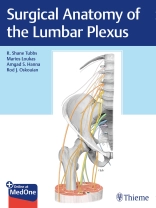Dedicated guide to the lumbar plexus provides invaluable anatomical and surgical insights
Thorough knowledge of the lumbar plexus and its branches is crucial to achieving positive patient outcomes, especially with newer surgical approaches. Many of the nerve branches are formed within the psoas major muscle and careful dissection is necessary to free them during surgery to prevent damage. Moreover, the iliac vessels are medial to some of the larger branches of the plexus, such as the femoral and obturator nerves. In the retroperitoneal space, the kidney and ureter are nearby. In addition, due to the overlying peritoneal cavity and its contents, accessing the lumbar plexus presents considerable challenges.
Surgical Anatomy of the Lumbar Plexus is the only book on the market devoted to the lumbar plexus and its branches, focusing on anatomy and clinical applications, pathology, surgery, and imaging. Internationally known authors R. Shane Tubbs, Marios Loukas, Amgad Hanna, Rod Oskouian and a cadre of esteemed specialists provide unique insights, clinical pearls, knowledge based on thousands of spine surgeries, and a well-rounded multidisciplinary perspective.
Key Highlights
- Nine separate chapters dedicated to impacted nerves: subcostal, iliohypogastric, ilioinguinal, lateral femoral cutaneous, genitofemoral, femoral, obturator, furcal, and accessory obturator
- History and overview of dermatomal anatomy of branches derived from the lumbar plexus
- Anesthetic blockade of the femoral, lateral femoral cutaneous, iliohypogastric, ilioinguinal, and genitofemoral nerves
- Tips for preventing complications and achieving positive outcomes for lateral transpsoas approaches to the lumbar spine and other procedures
- More than 100 novel illustrations provide clarity and understanding of a complex anatomical area as it relates to surgery involving the lumbar plexus and branches
This o
สารบัญ
1 An Overview of the Lumbar Plexus
2 Subcostal Nerve
3 Iliohypogastric Nerve
4 Ilioinguinal Nerve
5 Lateral Femoral Cutaneous Nerve
6 Genitofemoral Nerve
7 Femoral Nerve
8 Obturator Nerve
9 Furcal Nerve
10 Accessory Obturator Nerve
11 Variations of the Lumbar Plexus
12 High-Resolution Magnetic Resonance Neurography of the Lumbar Plexus
13 Lesions Involving the Lumbar Plexus
14 Injury to the Lumbar Plexus Following Lateral Lumbar Spine Fusion Procedures
15 Lumbar Plexus Anatomy with Application to Lateral Approaches to the Lumbar Spine
16 The Subcostal Nerve during Lateral Approaches to the Lumbar Spine
17 Surgical Techniques for Approaching the Lumbosacral Plexus
18 Nerve Root Anomalies with Application to the Lumbar Plexus
19 Lumbar Dorsal Root Ganglia
20 History of the Dermatomes with Focus on the Contributions from the Lumbar Plexus
21 Dermatomes and the Lumbar Plexus
22 Anesthetic Blockade of the Femoral Nerve
23 Anesthetic Blockade of the Lateral Femoral Cutaneous Nerve
24 Anesthetic Blockade of the Iliohypogastric, Ilioinguinal, and Genitofemoral Nerves
25 Microanatomy of the Lumbar Plexus
26 Surgical Anatomy of the Lumbar Plexus with Emphasis on Landmarks
27 Comparative Anatomy of the Lumbar Plexus












